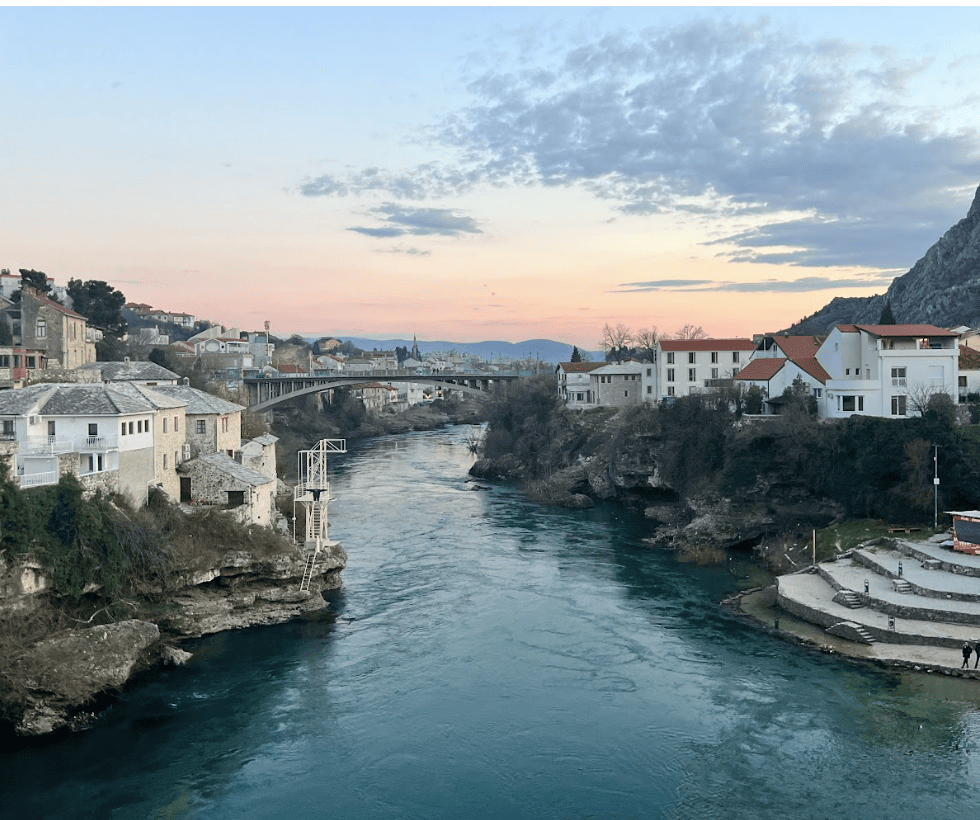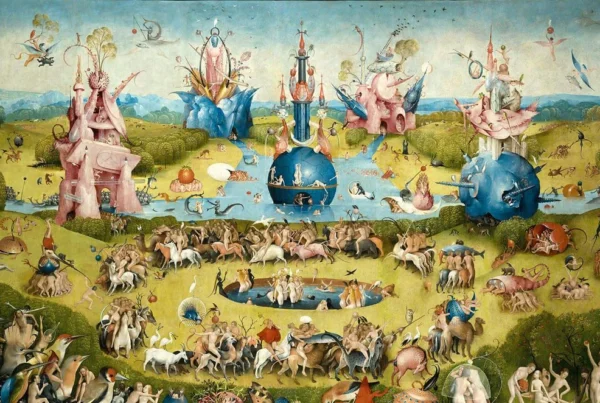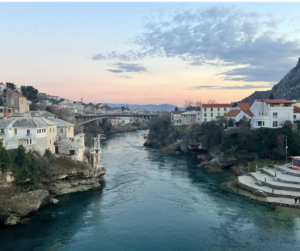
This spring break, my friends and I embarked on a journey through the Balkans. Our eleven-day trip spanned four countries and five cities: Belgrade, Sarajevo, Mostar, Zagreb, and Ljubljana. We were inspired by a curiosity for the recent history of the region and each country’s development in the past few decades. Additionally, the affordability of the region compared to the French cost of living made it an ideal location for a longer trip.
As we were planning our trip, most of our itinerary hinged on Bosnia and Herzegovina, since we were very interested in visiting the capital city of Sarajevo. Unfortunately for us, flights from Paris to Sarajevo tended to be less frequent, less convenient, and more expensive. We considered flying into Zagreb; however, we found it to be too difficult to travel from Zagreb into Bosnia. We therefore decided to fly into Belgrade, and traveled from country to country through buses booked through Flixbus.
We spent one day and night in Belgrade and took the night bus from Belgrade to Sarajevo, which was about a nine-hour journey. From there, we spent two days and nights in Sarajevo and took a morning train (around two hours) from Sarajevo to Mostar, where we spent three days and two nights. After that, we left Bosnia by taking another night bus (about an eight-hour journey) into Zagreb, where we spent three days and nights, including a day trip to Ljubljana on our second day. To return to France, we took a flight out of Zagreb airport.
Days 1-2: Belgrade
We arrived in Belgrade in the evening, after a long day of travel, and enjoyed a nice introduction to Balkan cuisine and the Belgrade nightlife. After our dinner, we headed to the Skadarlija neighborhood, which features a vintage pedestrian street lined with lively bars and restaurants. The drinks were inexpensive, compared to French or American prices, with cocktails costing around 6 euros. One cultural difference that we found in the Balkans was that they allow smoking indoors in most bars and restaurants, which left a strong smell of tobacco on our clothes.
Our second day started with sightseeing, thanks to a free walking tour we found on GuruWalk. Considering that we only had one full day to explore the city, we found that the tour was an efficient way to see the highlights of the city while learning about some of the history of Serbia and Yugoslavia, all within a few hours.
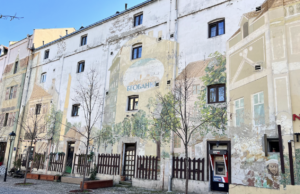
Murals in the Skadarlija neighborhood
After our walking tour, we had lunch at Iva New Balkan Cuisine, which is critically acclaimed with a Bib Gourmand distinction by the Michelin Guide. The restaurant highlighted Balkan fusion cuisine with a modern twist. We ordered wine, a corn potage soup with miso, pork cheek and apple salad, oxtail and gnocchi, and pork leg and parsnip (my personal favorite dish). The meal was absolutely delicious, displaying a wide variety of flavors. The total came out to be around 23 euros per person, which was an excellent value for the impeccable quality and quantity of food.
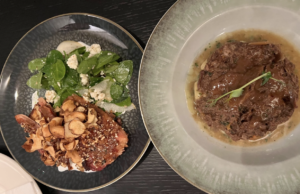
Pork cheek and apple salad and oxtail gnocchi from Iva New Balkan Cuisine
With Belgrade being the former capital of Yugoslavia, we were interested in learning more about the history of the former nation, so we headed to the Yugoslavia Museum. They had general information about the history of the country, displayed artifacts of diplomatic gifts to the infamous former President Josip Broz Tito (including a grain of rice engraved with his face), and most famously, Tito’s grave. We found that the museum lacked some information about the fall of Yugoslavia and the wars that ensued, with an absence of acknowledgement of Serbia’s role in the genocide of several ethnic minority groups.
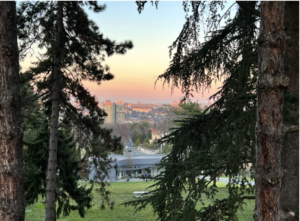
Sunset from the Yugoslavia Museum
Day 3-4: Sarajevo
The next morning at 7 am, we arrived in Sarajevo. We once again embarked on a walking tour of the city, learning about the history of Sarajevo and Bosnia and Herzegovina more broadly, with its history of Ottoman and Austro-Hungarian rule. Its history is present in its architecture, with our tour guide describing Sarajevo as a “two in one” of Vienna and Istanbul. The religious diversity is also evident in the city, with Ottoman-style mosques neighboring Orthodox and Catholic churches. Some of the highlights of the tour included visiting the exact spot where Gavrilo Principe shot Archduke Franz Ferdinand and the Copper Street — a narrow pedestrian street lined with shiny Bosnian coffee pots and shops owned by copper artisans.
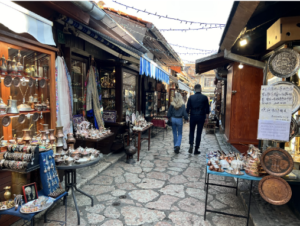
Copper Street in Sarajevo
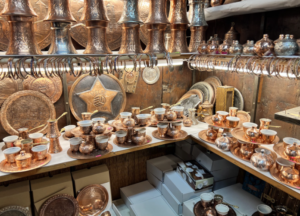
Inside a copper artisan’s store on Copper Street
Following the tour, we headed over to the town hall — a Moorish-inspired building built during the Austro-Hungarian rule, with a striped yellow and brick red facade. The building was stunning, with a striking bright exterior and intricate designs and colorful stained glass on the interior. There were several rooms explaining the history of the city, and the impact of the Siege of Sarajevo on the building, having been destroyed and rebuilt in the past 35 years.
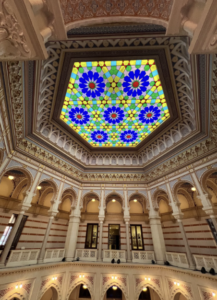
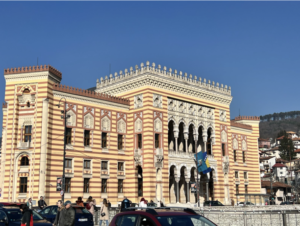
Sarajevo City Hall
Sarajevo has seen horrors in recent times and it is clear that it is still healing from the wounds of the Bosnian War, which took place between 1992 and 1995. We learned more about this history at the Museum of Crimes Against Humanity and Genocide and the Siege of Sarajevo Museum, both of which depicted the terrifying human rights atrocities that occurred in the war. Having known very little prior to visiting Bosnia, I found the museums to be incredibly insightful and educational, providing a Bosnian point of view to the fall of Yugoslavia, one that I felt was missing at the museum in Belgrade. Following our visit to the museums, we climbed the steep hills towards the Yellow Fortress for sunset and the view, including the sea of white stone graves on the hill, highlighting the sheer death toll and tragedy that occurred in Sarajevo during the war.
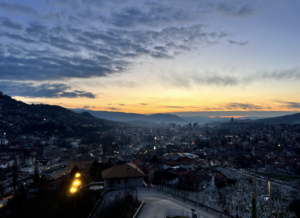
View from the Yellow Fortress
Day 5-7: Mostar
Our stop in Mostar, a small city in southern Bosnia and Herzegovina, gave us an opportunity to unwind and relax from the fast action of the first half of our trip. During our time there, we strolled around the slippery cobblestone streets of the quaint old town that surrounds the iconic Stari Most, or Old Bridge, after which the city takes its name.
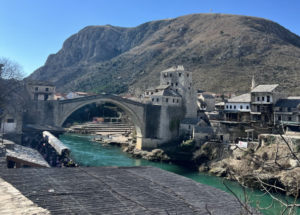
Old Bridge
We also took a day trip to Blagaj, a historic village located thirty minutes outside of Mostar. Blagaj features the source of the Buna River with pristine turquoise waters and a charming waterfall with the backdrop of impressive exposed limestone cliffs. We enjoyed a nice lunch by the river, with locally fished trout.
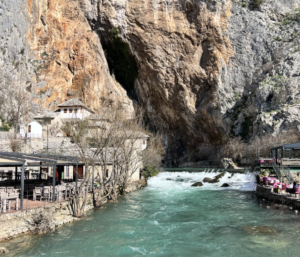
Blagaj
On our last day in Mostar, we took yet another walking tour of the city, where we learned about the city’s history. Our tour guide was a soldier for the Bosnian forces and had lived in Mostar through the siege and the war. He discussed the geographical ethnic segregations of Mostar and the generational legacy of the war with regard to ethnic divisions. Today, negative sentiments between ethnicities remain, with a strict separation between ethnic neighborhoods.
Day 8-11: Zagreb and Day Trip to Ljubljana
Although the city is beautiful, in my opinion, Zagreb left a little bit to be desired in terms of activities available. It is clear that the city is eagerly trying to invigorate a youthful atmosphere with “fun” museums such as the Museum of Hangovers, the Museum of Broken Relationships, and the Cannabis Museum, but personally, I found myself uninterested in these and was looking for activities with more cultural substance to learn more about the history of Zagreb and Croatia.
Among the attractions that we visited were the Zagreb City Museum, the Strossmayer Promenade, and the Grič Tunnel. Otherwise, we engaged in Zagreb’s vibrant nightlife scene, with our favorite spot being Spirit Bar, with 2-euro gin and tonics and other various cocktails during their happy hour, alongside Valhalla Beer Bar, which featured a wide variety of draft beers at affordable prices.

View from Strossmayer Promenade
After exploring Zagreb’s nightlife scene, our day trip to Ljubljana was one of the highlights of our trip. Situated only two hours from Zagreb, we were excited to include the city in our itinerary, as it had been a bucket list destination for us. The city was very charming and clean, with a picturesque old town showcasing Baroque and Renaissance architecture. We visited the National Gallery of Slovenia, which showcased a variety of almost exclusively Slovenian artists. Additionally, Ljubljana had a great thrifting scene with many affordable second-hand stores with a diverse selection of styles.
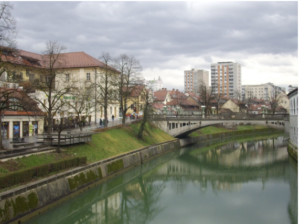
River Ljubljanica
Our spring break adventure throughout the Balkans was nothing short of extraordinary and was one of my favorite trips that I have ever taken. As we boarded our flights back to France, I carried with me wonderful memories and a newfound appreciation for the complexities and beauty of the Balkans, with its rich history and vibrant culture.
Other posts that may interest you:
- The Trouble with ‘Ecocide’
- Carbon dioxide removal – hit or miss?
- Local Victories for Turkish Opposition — A Sign of Hope?
- Are France and Japan a Mismatch Made in Heaven?
- A Reflection on Dark Tourism
Discover more from The Sundial Press
Subscribe to get the latest posts sent to your email.


